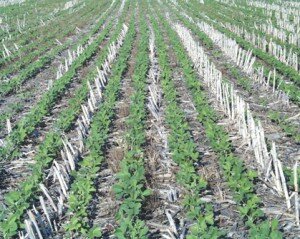Tips for successful no-till soybean production

No-till soybean field. Photo credit: Iowa State University
No-till farming is a growing practice in many areas of the United States. An estimated 50 percent of the acres planted to soybeans in 2009 were done so without tillage according to a recent USDA Economic Research Service report. Farmers are adapting no-till soybean production at a faster rate than they are for corn, cotton and rice.
There are many motives for adapting no-till. Some see it as a “greener” way to produce a global food supply while conserving soil and water resources so generations to come will be able to enjoy the benefits we do. Others see it as building resiliency into a production system faced with challenges of floods, drought, diseases and pests influenced in part by changes in climate. No matter what the reason, no-till practitioners are emphatic in their belief that it contributes to the sustainability of soybean production.
Long time practitioners of no-till admit there is no one way of doing it. Soils respond differently to no-till, so no single piece of equipment or common practice guarantees success. Successful no-tillers admit, however, they’ve learned from their mistakes and from listening to others.
Jim Specht, University of Nebraska, professor of agronomy offers these words of advice for getting the most out of no-till soybean production systems.
Plant early - Iowa State University reports delayed planting of high yielding fields results in a yield loss of 0.3 to 0.7 bushels per acre per day with the largest yield reductions occurring after May 10. In Nebraska, the yield penalty for delayed planting is between 0.3 and 0.6 bushels per acre per day of planting delay after May 1.
Choose soybean varieties wisely - Variety selection for field-specific problems such as diseases and SCN is important for success in no-till. Loren Giesler, University of Nebraska Extension plant pathologist agrees and says, “Farmers who know they have SCN can gain, on average, five to six bushels per acre simply by planting a SCN-resistant soybean variety, according to yield trials.”
Use a fungicide seed treatment - There is no doubt that seed-applied fungicides improve stand establishment in cool soils common in no-till fields. This is especially important to famers who are planting fewer seeds per acre to reduce input costs without sacrificing yield. To them, every plant counts. To others, it’s insurance. University studies show that soybeans are very resilient and will compensate for a few missing plants.
The benefit of using an insecticide seed treatment is unclear. Some university research shows that an insecticide seed treatment alone doesn’t always improve yield. The research also shows yield increases are inconsistent when an insecticide/fungicide seed treatment is used. Although the industry doesn’t have a complete understanding of how to use this technology, the observed benefits can’t be ignored.
Consider strip tilling soybeans in heavy residue situations. For those soybean producers whose prior crop corn yields were high, there will be a lot of corn residue left behind. Specht says, “For every pound of grain removed there is a pound of residue left behind so, a 250 bushel per acre corn crop leaves behind 14,336 pounds of residue per acre.” He suggests producers will get better planter soil closure over the soybean seed if a strip of corn residue has been cleared. The soil in that strip also warms up faster, which benefits early planted soybeans.
Every year more farmers are seeing the wisdom and rewards — both economic and personal — in no-till soybean production systems. Because each farm is different, there’s no single formula for sustainable success in no-till, but these principles are a good place to begin.